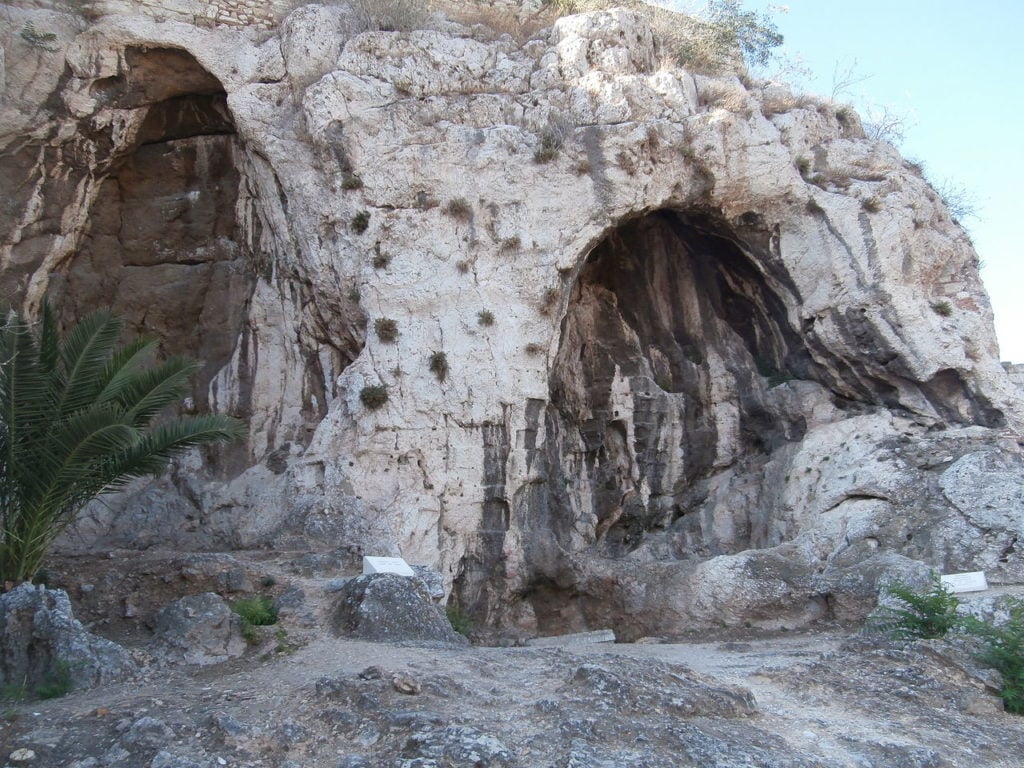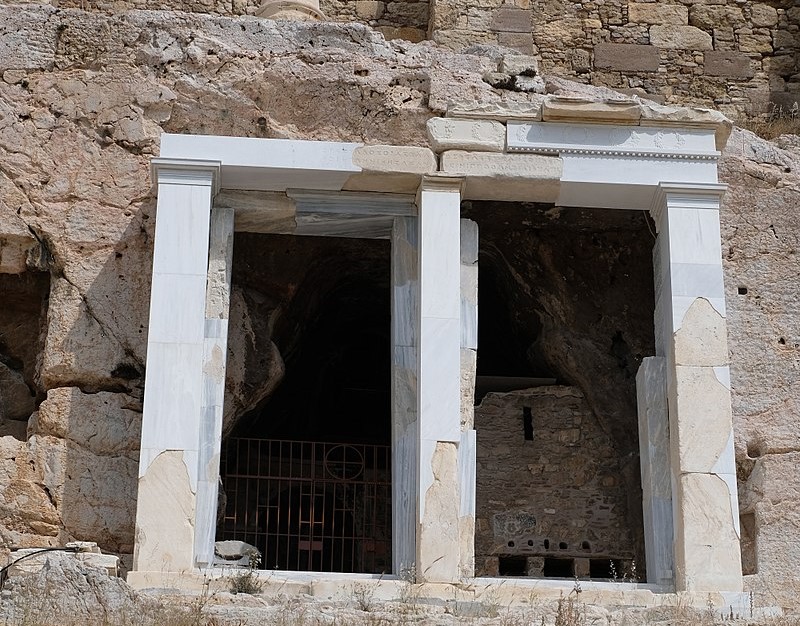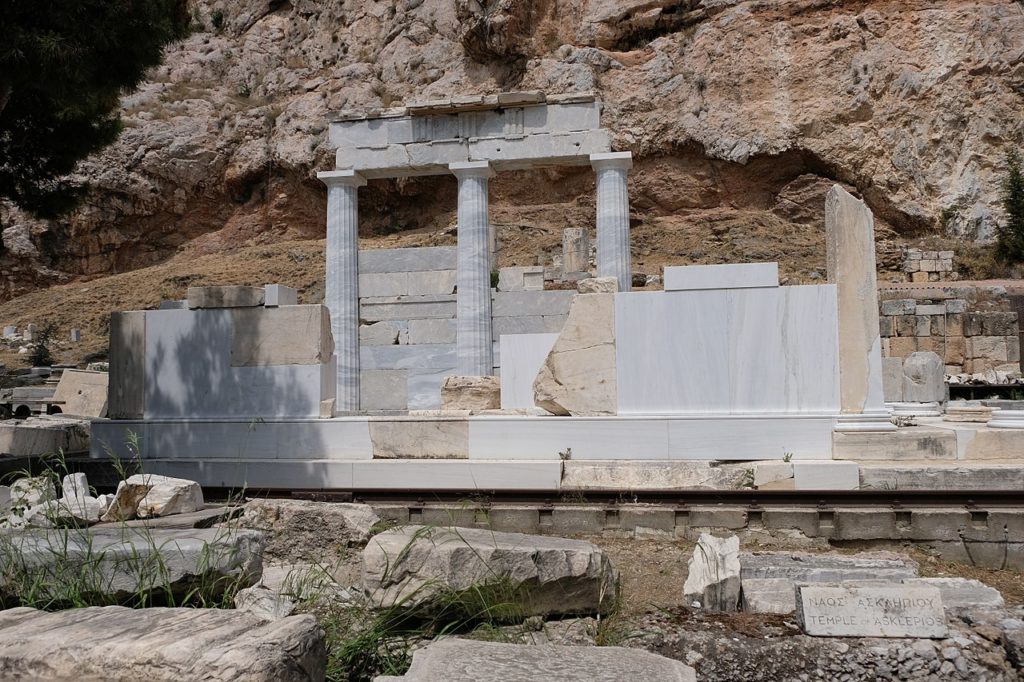The cave where the spring flows to this day is the largest on the southern slope of the hill. As for the basilica, only a few scattered marbles and pillars remain. These are currently undergoing restoration.

The cave where water still flows unaffected by the passage of time is closed to the public for security reasons.
History of the Acropolis Cave and the Asclepius Sanctuary
The Temple of Asclepius at the Acropolis was the initiative of a rich Athenian by the name of Telemachos Acharneos, who brought the worship of Asclepius from Epidaurus in 419 BC. Since Asclepius was the god of medicine, the Asclepieion was a complex with the temple, an altar for the god, and two galleries. The Doric gallery accommodated overnight patients, and the Ionian gallery served as the living quarters for the temple priests and their visitors.
At that time, Athens was suffering from the devastating plague that killed about one quarter of its population, and the Athenians were in dire need of the help of the god of medicine.
The priests of Asclepius used the healing method of incubation (enkoimisis), meaning that the patients would sleep at the infirmary gallery and meet the god in their dream. These were instances of miraculous healing from the god Asclepius himself.
Prior to the incubation, patients would ritually go in the cave and wash in the Sacred Spring of Asclepius to cleanse and purify themselves. The sacred water from the spring was the most important part of the ritual. After that, they would go to another chamber in the cave to make a sacrifice to the god.
They would then go to the gallery and sleep in expectation that Asclepius would meet them in their sleep. The god would touch the ill person, speak to them, or give instructions on how to heal themselves.
The following morning, the patient would describe their dream to the priest and tell them what to do to recover. In the second century AD, a secret cave was carved within the cave containing a well. This came to be known as the Hourglass Well. There was another spring running below it.
The Water of Asclepius Turns to Holy Water
From the fourth century AD and on, polytheism was losing ground, and Christianity was spreading, prevailing in religious consciousness and worship practices. The mixing of elements of the pagan past with the new religion would prove to be a happy compromise.
Patterns of centuries past were assimilated and became part of the new rituals, and the attributes of the ancient gods to whom people turned for help were attributed to the saints of the new Christian religion.
By the sixth century AD, the complex of the temple of Asclepius was demolished, and its materials were used to build a three-aisle Early Christian basilica entirely converted to a Christian church. The cave with the spring became a small Orthodox chapel.
However, worship in the small church continued into the twentieth century with Christian believers maintaining that the water of the timeless spring was holy. Researcher Ioannis Travlos assumes that the chapel in the cave is dedicated to Agioi Anargyroi, the two saints of medicine, Cosmas and Damianos, who, according to Greek Orthodoxy, are protectors of doctors.
The Church of Virgin Mary in Another Acropolis Cave
Another Orthodox Christian church has survived through the centuries, hidden in the southern slope of the Acropolis hill. It is literally hidden behind an ancient Greek monument.
Its long history begins in 320 to 319 BC, when the Choragic Monument of Thrasyllos was erected south of the Acropolis to commemorate the agonothetes of the Great Dionysian Games, Thrasyllos, who won in the chorus competition. Thrasyllos built the monument to have his trophy on permanent display in a spot visible from the whole city of Athens.
It was built in the form of a small temple and fills the opening of a large, natural cave on the Acropolis hill slope. Ancient Greek historian Pausanias refers to the monument indirectly, providing us with the information that inside the cave existed a representation of Apollo and Artemis slaughtering the children of Niobe.

In the later days of Ottoman rule, a Christian naydrium was built inside the cave, dedicated to Panagia (Holy Mary) Spiliotissa. The sponsored monument was kept almost intact with some formal alterations, such as the blocking of its openings with walls. Because of its prominent position, its idiosyncratic architectural form, and its good preservation, it was a favorite subject in the historical iconography of the monuments of Athens in the eighteenth and early nineteenth centuries.
Today, three of its structural parts remain standing, while the rest lie on the ground. The monument collapsed when hit by a cannon in 1827. This was during the siege of the Acropolis by the Turks towards the end of the Greek War of Independence.
In its current form behind the facade of the ancient monument, Panagia Spiliotissa was constructed following the cave’s ancient formation with a tripartite internal structure. In the nineteenth century, it was a popular church for Greek Orthodox Christians. Its location on the Acropolis hill signified the meeting of ancient Greece and the modern Greek state, reborn after almost four hundred years of Ottoman rule.
Panagia Spiliotissa was most favored by women. They visited the monument to pray for help when their babies were ill. Concurrently, however, the church served as a place where adulterous women were publicly shamed.
Impressive Wall Paintings
The holy icon paintings on marble within the Acropolis cave-turned-church, currently removed for restoration, are impressive, according to restorers. Saint Spyridon, John the Evangelist, and a large rendering of Abraham’s Hospitality with three emblematic seated angels adorned the front. This was visible upon entrance.
In the rear is yet another impressive icon on marble depicting the Dormition of the Mother of God, which is also currently being restored. Byzantine art experts say the mural decoration of Panagia Spiliotissa includes some of the best surviving examples of post-Byzantine hagiography in the area of the Acropolis and its slopes.
See all the latest news from Greece and the world at Greekreporter.com. Contact our newsroom to report an update or send your story, photos and videos. Follow GR on Google News and subscribe here to our daily email!




